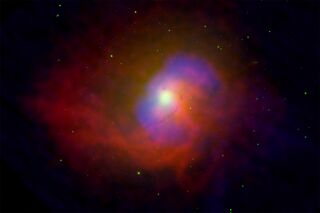Astronomy:NGC 4696
From HandWiki
Short description: Elliptical galaxy in the constellation Centaurus
| NGC 4696 | |
|---|---|
 | |
| Observation data (J2000 epoch) | |
| Constellation | Centaurus |
| Right ascension | 12h 48m 49.3s[1] |
| Declination | −41° 18′ 40″[1] |
| Redshift | 2958 ± 15 km/s[1] |
| Distance | 116 ± 9 Mly (35 ± 3 Mpc)[2] |
| Apparent magnitude (V) | 11.4[1] |
| Characteristics | |
| Type | E1 pec[1] |
| Apparent size (V) | 4.5′ × 3.2′[1] |
| Other designations | |
| PGC 43296[1] | |
NGC 4696 is an elliptical galaxy. It lies around 145,000,000 light-years (44,000,000 pc) away in the constellation Centaurus. It is the brightest galaxy in the Centaurus Cluster, a large, rich cluster of galaxies in the constellation of the same name.[3] The galaxy is surrounded by many dwarf elliptical galaxies also located within the cluster.[3] There is believed to be a supermassive black hole at the center of the galaxy.[4]
One supernova, SN 2017ejb (type Ia, mag. 17.2), was discovered in NGC 4696 on 28 May, 2017.[5]
References
- ↑ 1.0 1.1 1.2 1.3 1.4 1.5 1.6 "NASA/IPAC Extragalactic Database". Results for NGC 4696. http://nedwww.ipac.caltech.edu/.
- ↑ J. L. Tonry; A. Dressler; J. P. Blakeslee; E. A. Ajhar et al. (2001). "The SBF Survey of Galaxy Distances. IV. SBF Magnitudes, Colors, and Distances". Astrophysical Journal 546 (2): 681–693. doi:10.1086/318301. Bibcode: 2001ApJ...546..681T.
- ↑ 3.0 3.1 A. Sandage; J. Bedke (1994). Carnegie Atlas of Galaxies. Washington, D.C.: Carnegie Institution of Washington. ISBN 978-0-87279-667-6.
- ↑ Mohon, Lee (2017-04-18). "The Arrhythmic Beating of a Black Hole Heart" (in en). NASA. https://www.nasa.gov/mission_pages/chandra/the-arrhythmic-beating-of-a-black-hole-heart.html.
- ↑ Transient Name Server entry for SN 2017ejb. Retrieved 24 March 2023.
External links
- http://www.eurekalert.org/pub_releases/2010-08/eic-n4a081010.php
- http://apod.nasa.gov/apod/ap161207.html
Coordinates: ![]() 12h 48m 49.3s, −41° 18′ 40″
12h 48m 49.3s, −41° 18′ 40″
 |
